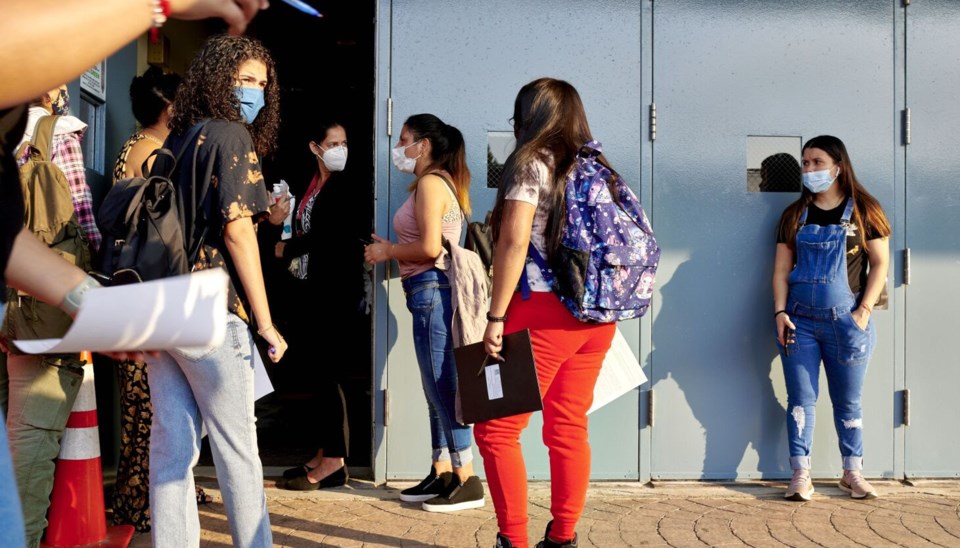In a surprising move, federal education officials announced last week that they had created a new $10 million grant program to fund school integration efforts.
The funding is a small fraction of the $100 million that President Biden has tried to get Congress to put toward this program since he was elected. But it represents a noteworthy, if small, win for integration advocates who’ve spent years lobbying the federal government to take a bigger role in supporting school desegregation.
“This is a relatively small grant program, but it’s part of a larger, multi-year movement,” said Philip Tegeler, the head of a civil rights organization, the Poverty & Race Research Action Council, who spoke at an event about the program this week. “The response to this program from local educational agencies and states is going to determine what happens in the future.”
Advocates hope that if the program attracts interest from many school districts, it could help build the case to boost spending down the line.
But it’s unclear how many school districts will want to take on the politically fraught and logistically complicated work of desegregating schools at a time when many communities are fighting over how to teach about race and racism in school, and some states and districts are retreating from the racial equity work they started in the wake of George Floyd’s murder.
Eighteen states now have laws or other restrictions limiting how schools can teach about racism and sexism, according to a tracker compiled by Education Week, and several school districts have brought back school police after removing them over concerns that they disproportionately arrested Black students. Many educators also are bracing for a decision from the U.S. Supreme Court that’s expected to prevent colleges from considering a student’s race in the admissions process.
Still, dozens of school districts, including some of the nation’s largest, have expressed interest in integrating schools in recent years and could be prime candidates for this new funding.
Notably, the new grant program prioritizes initiatives that would integrate students from different socioeconomic backgrounds, though prior versions of this program floated by Biden and others have included preferences for integration by both family income and student race. Federal officials say districts could still use this money to create more racially diverse schools, though that’s not the main focus.
Supreme Court rulings have made it very difficult for school districts to consider student race in desegregation plans and to create integration plans that cross school district boundaries, where most school segregation exists.
The roots of this program go back to 2016, when former Education Secretary John King tried to launch a similar initiative in the final days of the Obama presidency. The education department created a $12 million grant program and received applications from dozens of school districts that wanted to participate. But the Trump administration killed the program before it started.
“This very similar program was started in 2016, but folks never got awards,” said Kayla Patrick, a special assistant in the education department’s planning and policy development office. “We are really excited to have this opportunity to actually see the entire program through. Our hope is that this is just step one and we can get to the place where we’re scaling up.”
This time around, the education department is using existing funding through a federal program that’s meant to create safe and healthy schools and provide students with access to a well-rounded education.
“Research suggests that income segregation is increasing and that students in socioeconomically isolated schools (i.e., schools overwhelmingly composed of children from low-income backgrounds) have less access to the critical resources and funding that are necessary for high-quality educational experiences,” a notice for the grant states. “This disparity can ultimately have detrimental effects on the individual lives of students and the foundation of democracy.”
Federal officials expect to award four to eight grants to school districts that are in the planning stages of integrating their schools and one to three larger grants to districts that are putting their integration plans into action. The timeline is relatively short: Applications are due in July and work could begin as soon as the fall.
Some integration advocates say that even in the face of legal limitations, the federal government can do more than start a competitive grant program. That approach only appeals to districts that already want to do this work, but doesn’t touch the many places where there is little appetite for change.
“I think students deserve access to diverse learning environments in whatever communities they are,” said Halley Potter, a senior fellow at The Century Foundation, a progressive think tank that supports school integration, “even if those are communities that have a long way to go in terms of recognizing the need for integration.”
Kalyn Belsha is a national education reporter based in Chicago. Contact her at [email protected].
Chalkbeat is a nonprofit news site covering educational change in public schools.

